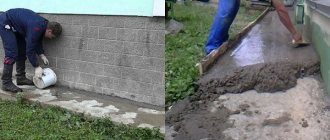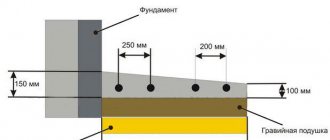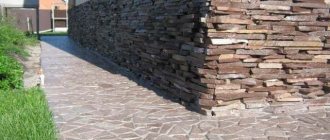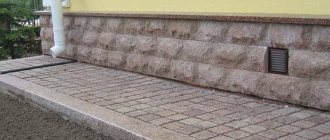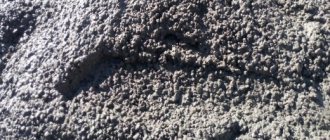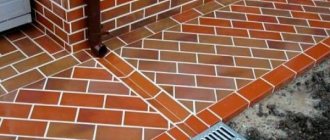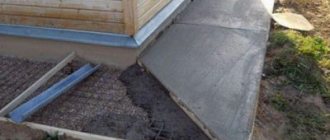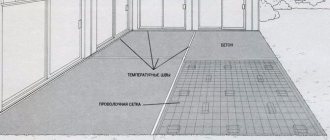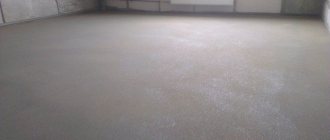The blind area is subject to the adverse effects of melt water, precipitation and temperature changes. In this regard, quite strict requirements are imposed on the “waterproofing tape” surrounding the perimeter of the building. Although the paths around the house are not subject to strong mechanical loads, they must have good frost resistance and water resistance, so the grade of concrete for the blind area is of particular importance when constructing structures of this type independently.
To prepare a high-quality concrete solution that will not begin to crack after the first winter, you need to pay attention to the proportions, quality and compressive strength of the main and secondary components of the mixture.
Quality of concrete mixture components
The composition of concrete for blind areas includes: sand, cement, crushed stone and water. The composition also includes fillers (up to 70% of the total mass of the solution) and astringent components. Such additives make it possible to give the material greater strength and elasticity.
If we talk about the qualities that components should have, then it is worth highlighting the following recommendations:
The sand must be free of any impurities (clay, silt and other substances). If this component contains at least minimal additives, the concrete mixture will be heterogeneous. Crushed stone should not contain lime.
Crushed stone made by grinding river gravel is considered to be the highest quality. The recommended grain size is 5-20 mm. Also, instead of crushed stone, you can use gravel and plasticizing additives. It is recommended to use only running water for the mixture. Expanded clay is often used as a filler, which significantly lightens the weight of the future concrete structure.
There are also no strict requirements for cement, however, for high-quality mixing of concrete, you need to pay attention to its markings.
Components and proportions for concrete mixture
How to make a good solution for a concrete blind area, what proportions should be taken into account? Let us note that the concrete must be of high quality, not lower than M-200 grade. Also take into account the frost resistance of concrete and its water resistance, since the blind area will be constantly exposed to precipitation.
It is best to ensure a high-quality mixture by purchasing concrete from the manufacturer's factory, but as practice shows.
It is quite possible to prepare a spinal solution for the blind area with your own hands. What will the composition of concrete include? Those who have read more than the first article on our website know for sure that only three components are needed: a base, a binder and, of course, water.
The finished solution and its quality will depend on the material you choose, as well as the proportions you choose.
The brand of concrete also depends on the proportion. Most of the load is borne by the aggregate, which is also the base of the concrete solution. This can be sand, crushed stone, expanded clay, slag, broken bricks and mixtures thereof. Often used when preparing a mixture for a concrete blind area are fine aggregate, sand and coarse crushed stone. We need concrete of the M200 grade and we start from this when choosing cement. We know the rule that cement should be taken with a grade higher than the grade of the required concrete twice as high.
This means we need grade M400 and higher. In addition, the higher the grade of cement, the lower its consumption for the mixture we need. For paths, concrete screeds, as well as the blind area we need, use concrete M200 - the most popular. It's even better to take M250 to give more strength.
Concrete marking
By marking concrete, you can determine the compressive strength of this material. Let's look at the most common brands that are recommended for use when building a private house:
Brand of concreteField of useStrength, kgf/cm2Water resistance/frost resistance, W/F Strength class M 200 Concrete screed; Blind area; Staircase; Paths 196.4W2/F50B 15M 250 Lightly loaded floor slabs; Strip fence; Concrete blind area 261.8W4/F100B 20 M 300 Blind area; Paths; Foundation; Floor slabs; Retaining walls294.6W6/F200V 22.5
Grades 100-150 are not suitable for arranging street structures, and M 400-500 are used for the construction of multi-story buildings, so this concrete is rarely used for private construction. Compositions M 250 and M 300 can also be called unprofitable, since their cost is “an order of magnitude” higher. The best option for a blind area would be M 200 concrete, which is distinguished by its affordable price and high quality.
Proportions for concrete M 200
To independently prepare concrete mortar grade M 200, you need to mix the following components in a certain proportion:
- Portland cement M 400 – 287 kg. Crushed stone (size from 5 to 20 mm) – 1135 kg. Sand and gravel mixture (SGM) – 751 kg. Water – 186 l.
Healthy! The standard ratio of sand, cement (M 400) and crushed stone for the blind area is 1: 2.8: 4.8.
There is also an alternative recipe:
- Cement – 287 kg. Sand – 803.6 kg. Crushed stone or gravel 1377.6 kg. Water – 186 l.
Healthy! The water-cement ratio (WCR) is usually 0.65:1, but this can be changed if the sand or AGR is too wet.
To obtain the best mixture, it is recommended to purchase cement only from trusted manufacturers.
It is important to take into account the fact that PC retains its properties for no more than 3 months (after which it loses up to 30% of its strength properties), so if you buy it at a hardware store, be sure to pay attention to the production date of the composition. The marking must be second-by-second; if the packaging with concrete only shows the day and month, then it is a fake. The same applies to two bags with the same second-by-second marking.
Healthy! Today, fake cement made from dolomite or lime is quite common. If you use such compositions to prepare concrete for a blind area, then you risk getting a low-quality structure.
How to install a circular blind area made of concrete for a private house
The implementation of this operation, like all construction processes, consists of performing a set of specific works. Let's briefly look at some of them.
Tools and materials
It makes no sense to talk once again about the need to use high-quality materials, however, it is worth recalling that the proportions of the components when preparing concrete for the blind area directly depend on their characteristics .
The list of required materials is as follows:
- clay - for making the underlying layer;
- sand - for a separating layer over clay;
- crushed stone - for forming a drainage layer (fractions up to 20 mm) and preparing a concrete mixture;
- hydrophobic material - roofing felt or polyethylene for waterproofing;
- metal mesh for reinforcement;
- boards for formwork 20 mm thick.
List of equipment for work:
- building level;
- two-meter rail;
- plastering tools;
- equipment for digging and carpentry;
- vibrator for compacting the mixture.
Technological process of arranging a blind area
First of all, markings should be made for the entire structure; the width of the tape was written above. Next, the process occurs step by step :
- along the perimeter of the building along the entire width of the tape, remove soil to a depth of 200-250 mm;
- make formwork;
- compact the soil;
- lay a layer of clay about 50 mm thick and compact it;
- spread a layer of sand about 100 mm thick onto the clay and compact it thoroughly;
- lay a layer of crushed stone 60-70 mm thick;
- to strengthen the structure, install reinforcing mesh;
- organize an expansion joint in concrete in the area of the connection between the plinth and the concrete strip;
- lay a layer of concrete, compact and level the surface.
It is important not to forget that the installation of expansion joints for concrete blind areas must be done every 2-2.5 meters , and at the corners of the house their presence is simply mandatory. To do this, you can use slats that are placed flush with the surface, taking into account the degree of its slope.
The so-called wet ironing will help to achieve maximum strength of the concrete coating. Optimal drying is ensured by laying fabric on the tape, which is periodically moistened.
Preparation of concrete mixture
To prepare a solution for a blind area, follow these steps:
- Pour clean water into a concrete mixer (an old bathtub, basin or bucket). Add cement and mix it with water until “cement laitance” (a light-colored liquid solution) is formed. Pour crushed stone into the solution, wait 30 minutes and mix all the components again. The larger the crushed stone, the less water you will need to prepare the solution. Add sand and mix the mixture until a thick, homogeneous mass is obtained. Pour concrete into the formwork for the blind area.
Healthy! It is recommended to carry out work at a temperature not lower than +5 degrees. If you plan to build a blind area in the cold season, then before pouring the concrete solution, it must be warmed up.
In order to calculate how much dry mixture you will need, you need to:
- Determine the total area of the blind area (to do this, multiply its length by its width). Multiply the resulting number by the height of the blind area. Add 15% to the resulting number (this is the mixture reserve).
Thus, if the area of the blind area is 20 m2 and its height is 17 cm, then we get:
20 x 0.17 = 3.4 + 15% = 3.9 m3 (this is the amount of mixture you will need for the blind area)
If you live in a region with a rather harsh climate where it often rains, then it is recommended to increase the water resistance of concrete. To do this, it is enough to add additives to the solution such as: Penetron, Aquatron or any other additives that increase moisture resistance. You can also significantly increase the surface's resistance to moisture by using iron plating.
What proportions should you take, you ask?
In order to get the classic M200, you will need to take one part of M400 cement, 2.8 parts of sand and 4.8 parts of crushed stone. If you want to make a higher grade, then pay attention to M250 from M400 cement one part, 2.1 parts sand and 3.9 parts crushed stone. For the M300 the ratio will be something different: 1:1.9:3.8.
Try to use the smallest amount of water possible; it is better to use 0.6 water per part of cement. Don't forget about the moisture content of the sand. First add cement to the concrete mixer, then water, mix and then just add crushed stone and finally sand.
Note that different sources have different recipes, so it’s easier to focus on consistency and develop your own recipe through practice. We also offer you a table on how to create concrete from M400 cement of different grades:
How to calculate the amount of concrete? You need to take into account the surface area of the blind area. And then multiply the calculated area by the height of the blind area. An area equal to a certain number should be multiplied by 15 cm in height. For example, 30 sq. m.
by 0.15 m. We get 30x0.15 = 4.5 m3. This will be the required amount of concrete solution. Don't forget to take some stock as well.
Features of this structure
Construction specialists offer us the simplest, most intuitive classification of types of blind areas around the house. This classification is based on the type of materials that are used to create such structures. So, there are these types of protective structures:
Soft.
It is made of crushed stone or gravel. Semi-rigid. This design is made of stone or paving slabs. Rigid. Made from heavy concrete.
Since it is the latter option that is recognized as the most popular, its characteristics are worthy of special attention. The hard version in practice turns out to be the most durable in its segment. Thanks to its properties, it guarantees complete protection of the foundation and plinth from the destructive effects of moisture.
Negative effects of moisture on the foundation
Technology for constructing a blind area made of concrete with insulation
Step-by-step instruction:
Preparing the base for the blind area
. To do this, the top layer of soil is removed, all roots, stones, etc. are removed. Using a blanket herbicide will eliminate activity under the substrate. For example, the drugs Agrokiller or Tornado.
Advice. Considering that the blind area must exceed the edge of the roof slope by 200 mm, it is recommended to use a plumb line to accurately mark the boundary of the blind area.
Marking
. To do this, we pull the rope onto the stakes hammered in the corners. To avoid sagging of the rope, you need to install intermediate stakes (at a distance of 5-6 m from each other).
Advice. How to determine the required angle of inclination of the blind area? Craftsmen install additional beacons (stretch a rope) on the base of the house. Fastening is done every 1-1.5 meters.
Hydraulic lock device
. To do this, lay fatty clay in a layer of 100-150 mm or cover the bottom with geotextiles (roofing felt, PVC film, advertising banner, etc.). Please note that to prevent the film from tearing, it is better to pour a layer of sand of 50-100 mm at the bottom of the trench. A layer of sand of the same thickness is also poured on top of the film. The sand is leveled, moistened and compacted. In the case of a clay hydraulic lock, there is only one sand layer. When laying the film, you should avoid tension. It must be able to move freely with the ground.
Note. Experts advise making high-quality drainage near the hydraulic lock. To do this, you need to dig a trench 100 mm deep and 200 mm wide and fill it with crushed stone or lay a drainage pipe in it, wrap it with geotextile and fill it with crushed stone. This will increase the rate of water drainage.
It is worth noting that many people ignore this stage of work. In practice, this attitude results in the fact that the water passing through the expansion joint goes directly under the foundation, and when it freezes, it leads to an increase in pressure on it.
Backfilling of crushed stone
. The layer thickness varies from 50 to 100 mm. The gravel is leveled and compacted. Since crushed stone is difficult to compact, some recommend using a special grid for laying it, which is used in landscape design for making gravel paths. We note right away that this will increase the cost of the blind area without much need.
Backfilling with sand
.
Laying communication pipes
. To do this, a depression is made in the sand for pipes and storm drains.
Insulation of the blind area
. Expanded polystyrene or penoplex is laid on the compacted sand with which crushed stone and communications are covered. Only hard insulation is suitable for the blind area, but it is afraid of point loads, so it must be laid on a sand cushion.
Advice. Cold bridges can be eliminated by laying insulation in two offset layers.
Reinforcement of concrete blind area
. This is done by laying reinforcement mesh with cells of 50x50 or 100x100 mm or by knitting a reinforcement cage.
Advice. Chain-link mesh is not suitable for reinforcement - it is too flexible.
If insulation is not intended, the reinforcing mesh is laid directly on the crushed stone to a height of 20-30 mm. Which will contribute to better distribution of concrete.
Formwork installation
. Boards or plywood are installed strictly according to level. To level out the pushing force of concrete, the formwork is reinforced with stakes that are installed on its outer side. During installation, do not forget that the formwork is removable, which means that all seams will be visible after its dismantling. In this case, the blind area will have an ugly appearance. Therefore, when installing boards, you need to ensure that the internal seams are invisible.
Construction of expansion joints
. To do this, we install wooden slats and boards (on edge), which are pre-treated with an antiseptic or tarred. The recommended distance between the expansion joints of the blind area is 2-2.5 meters. Expansion joints must be made diagonally in the place where the formwork turns (at the corners). The purpose of the expansion joint is to compensate for the thermal expansion of concrete during operation. They are installed level, taking into account the angle of inclination of the formwork, because When pouring concrete, they are guided by them. An alternative to wood can be Guerlain butyl rubber tapes (10 RUR/m) or a hydro-swelling elastic cord, for example, Penebar Rapid SW45 A/B.
How to seal the seams in the blind area?
According to reviews, those who ignored the formation of expansion joints had cracks after the first winter. Many people believe that wood swells and allows moisture to pass through. You can seal the resulting cracks with special sealants, such as TEKTOR 103 mastic (225 rubles/piece), ISOSEAL P-40 (280 rubles/piece).
Pouring a concrete blind area. When pouring concrete, you need to ensure that no air pockets are formed and that the cement mixture evenly fills the entire space. It is important that no bumps or depressions appear when pouring. Their presence will lead to stagnation of water in these places. If it is not possible to do the entire blind area at one time, part of it is poured, and then work is resumed.
Advice. When pouring a blind area, you can use a technique for uniform distribution of concrete - bayoneting. To do this, the concrete is “pierced” with a rod, and the solution fills the entire space.
How to properly pour a concrete blind area around a house - video
The most reliable option
Regardless of what brand of concrete you use for the structure described, it itself is quite simple. It is quite possible to create it with your own hands, without spending a lot of time and without making Herculean efforts. It traditionally consists of several blocks, namely:
- a layer of soil, pre-compacted; a waterproofing layer; a sand layer, the thickness of which should reach 10 centimeters; a layer of insulation; a tape made of cement.
Scheme of the blind area
The above scheme is generally accepted. However, it may change depending on the individual characteristics of a particular situation.
Requirements for building materials
The blind area is a path that frames a private house. Experts classify tracks of this type as unloaded heavy tracks. This is due to very favorable operating conditions: not only will hundreds of pedestrians not walk along the path at the same time, but, even more so, cars will not drive.
This structure must first of all be waterproof. Therefore, when choosing which concrete to use during construction work, pay attention to low grades. They best meet the requirements, which are necessarily provided by specialists.
Composition and technical characteristics of concrete
The grade of concrete for the blind area should be:
- waterproof; resistant to frost; average strength indicators; maximum affordable, because the low price will optimize financial costs and the entire construction process as a whole.
Which brand should you choose?
Since the described protective structure is not susceptible to special functional and structural loads, you can save a lot on building materials for it. In this situation, it is quite rational to seek the advice of professionals.
They argue that in this case a low grade of concrete is needed; however, a fairly responsible approach to performing the work is also needed. For such a structure, use building material of class M100; M150 is also suitable. They are the most popular solution when it is necessary to design paths around a private house.
If savings are not important to you, choose the M200 class. It is more expensive, but its performance characteristics are much better. For example, this class of building material is characterized by special strength and excellent resistance to frost and water.
Concrete grade Strength, kgf/cm 2 Water resistance Frost resistance Cost, rub./cubic meter M100 (H 7.5) 98W2F503500 M150 (H 10) 131W2F503550 M150 (H 12.5) 164W2F503600 M200 (H 15) 196W4F1003800
Proportions for solution
Each brand of cement requires individual proportions when adding sand.
If the ratio is violated, this will certainly affect the quality of the cement mixture. For the installation of a blind area, it is best to choose cement from M300 to M500. These brands are universal and ideally combine all the necessary functions.
You can obtain M100 concrete in several ways:
- 1 part M300 cement to 2.5 parts sand;
- 1 part M400 cement to 3 parts sand;
- 1 part M500 cement to 4 parts sand.
For concrete M200 you will need to reduce the amount of sand:
- 1 part M400 cement to 2.5 parts sand;
- 1 part M500 cement to 3.5 parts sand.
Low grades of concrete are suitable for creating floor screeds or carrying out plastering work. For a blind area, as well as for pouring a strip foundation for a house, you will need concrete with a strength of at least M200.
Water plays an important role in the ratio. Its amount, as a rule, is half the weight of cement. For example, for 500 kg of cement you will need 1500 kg of sand and 250 liters of water. If you shift the amount of water downward, the solution will become thicker and its strength will be higher.
We draw your attention to the article about the blind area made of crushed stone. And in this article, read how to properly pour a strip foundation.
Maintain proportions
Since the mixing of concrete mortar and subsequent pouring of the blind area is often done by home owners themselves, the importance of maintaining the correct proportions when mixing the mixture should be emphasized. We are talking about the proportions of the following ingredients:
- sand;water;cement;gravel.
Brand Proportions sand : cement M400 : crushed stone Proportions sand : cement M500 : crushed stone Ratio of water to cement grade 400 Ratio of water to cement grade 500 Concrete yield from 10 liters of cement M400, l Concrete yield from 10 liters of cement M500, l М100 (V 7.5)1: 4.6 : 7.01 : 5.8 : 8.10.830.867890M150 (H12.5)1 : 3.5 : 5.71 : 4.5 : 6.60.70.726473M200 (H15)1 : 2.8 : 4.81 : 3.5 : 5.60.580.645562
This table displays the standard proportions of ingredients in an accessible form. You can vary the number of components yourself, depending on the individual characteristics of your existing construction site and the upcoming operating conditions.
Proportions
Buckets can be of different sizes (from 5 to 15 liters), so for accurate calculations it is most convenient to use the weight of the components. If you know the volume of the concrete mixer itself, then it is not difficult to determine the required amount of substances in the buckets. You just need to figure out the brand of ready-made concrete.
To make one cubic meter of concrete, the following amount of materials is required:
| Components | M400 | M500 |
| Cement, kg | 338 | 292 |
| Sand, kg | 642 | 702 |
| Crushed stone, kg | 1250 | 1258 |
| Water, l | 170 | 146 |
This calculation is carried out if the cement is poured in stages (depending on the volume of the concrete mixer), and the process itself does not last long. It should be taken into account that calculations are carried out for laying concrete under normal climatic conditions. Relative air humidity is from 60 to 75%, and temperature is from +15 to +25 C.
In buckets
To calculate the amount of materials in buckets, the indicated numbers are converted to liters. The values are not completely accurate due to the variable density of bulk materials, but they are enough to prepare workable concrete. The bulk density of cement is 1200 kg/m3, sand - 1440 kg/m3, and crushed stone - 1600 kg/m3.
After translation, the following values are obtained:
| Components | M400 | M500 |
| Cement, l | 281 | 243 |
| Sand, l | 445 | 487 |
| Crushed stone, l | 781 | 786 |
Now the obtained indicators are converted into buckets and it is calculated how many of them will be needed to fill the concrete mixer. Most often, 10 liter buckets are used in construction, and calculations will be made with this. But concrete mixers differ in size. For home use, novice builders buy devices with a volume of 70 to 250 liters. Since concrete mixers work in an inclined position, the amount of concrete produced will be less. Therefore, the calculation will be carried out for an average 55% occupancy rate.
The numbers next to each ingredient indicate the number of buckets for preparing concrete:
| Concrete mixer volume, l | Concrete grade, M | Cement | Sand | Crushed stone | Water |
| 70 | 400 | 1,1 | 1,8 | 3,1 | 0,7 |
| 500 | 1 | 2 | 3,1 | 0,6 | |
| 100 | 400 | 1,5 | 2,5 | 4,3 | 1 |
| 500 | 1,3 | 2,7 | 4,3 | 0,8 | |
| 120 | 400 | 1,8 | 3 | 5 | 1,1 |
| 500 | 1,6 | 3,2 | 5 | 1 | |
| 140 | 400 | 2,2 | 3,5 | 6 | 1,3 |
| 500 | 1,8 | 3,7 | 6 | 1,1 | |
| 160 | 400 | 2,5 | 4 | 7 | 1,5 |
| 500 | 2,1 | 4,3 | 7 | 1,3 | |
| 180 | 400 | 2,8 | 4,5 | 7,7 | 1,7 |
| 500 | 2,5 | 4,8 | 7,8 | 1,5 | |
| 200 | 400 | 3 | 5 | 8,5 | 1,9 |
| 500 | 2,7 | 5,5 | 8,7 | 1,6 | |
| 220 | 400 | 3,5 | 5,3 | 9,5 | 2 |
| 500 | 3 | 6 | 9,5 | 1,8 | |
| 250 | 400 | 3,8 | 6,1 | 10,7 | 2,3 |
| 500 | 3,3 | 6,7 | 10,8 | 2 |
In everyday life they operate according to a simplified scheme. To mix concrete, use the following proportion: 1 bucket of cement, 0.5 buckets of water, 2 buckets of sand and 4 buckets of crushed stone. If a plasticizer is added, then this is done in a thoroughly mixed material, after which the concrete mixer is started for another couple of minutes.
For the foundation
For the construction of the foundation, depending on its type, the following grades of cement are used: M200, M400 and M500. The calculation is carried out according to the same scheme as described above. The proportional ratio for the solution is selected 1:3:5 or 1:2:4 (cement:sand:crushed stone).
[ratingelements >Not all craftsmen know how to properly prepare concrete so that all components are thoroughly mixed. It is important to ensure that the consistency of the composition is thick and does not stick.
To solve these issues, it is necessary to clearly know the proportions of the components and the order of loading the concrete mixer. Before starting cooking, it is better to carry out calculations and prepare the ingredients so as not to be distracted during the process.
The procedure is as follows:
- 1/2 part of the water is poured into the container.
- Almost all the crushed stone is filled in, and the concrete mixer is turned on. At the beginning, you need to put crushed stone so that it can cope with breaking up the thick solution in the container. This will avoid clumping.
- The entire volume of cement spills out. Knead the resulting mixture until it becomes homogeneous.
- Now, without stopping the machine, pour out all the sand. At this stage you need to be especially careful and attentive. The resulting composition should look homogeneous without lumps of sand.
- To complete the preparation, the remaining part of the crushed stone is poured into the concrete mixer. When the device thoroughly mixes all the ingredients, the rest of the water is added to the container. After this, the composition is brought to a homogeneous state.
- When the mixture is ready, it must be carefully poured. To do this, the rotating concrete mixer is turned down so that the solution pours into the prepared bucket.
Important! After finishing mixing, it is necessary to wash the concrete mixer. To do this, use water and a trowel. This rule cannot be neglected, even if another batch of concrete is planned that day. Due to the remnants of the old mixture, lumps often appear in new concrete.
The most important property is water resistance
Water resistance, as well as frost resistance, are properties that are decisive for this design.
This is due to the functional purpose of the tracks. As practice shows, even if you correctly calculated the proportions of the concrete solution and did not violate the technology for performing subsequent work, the final result may not be as durable as you expected. The onset of the first cold weather will perfectly illustrate to you how successful the choice of this or that brand of cement was.
In order to get a path that is as resistant to moisture and frost as possible, you should give preference to the maximum price-quality ratio when choosing building materials. The ideal solution for anyone who wants to become the owner of good protection for the foundation of their own private home for little money is not to save on the brand of cement.
It is enough just not to spend money on unnecessary building materials and not to waste labor and time resources. Concrete for the blind area: which brand to choose? updated: December 18, 2016 by: Artyom The choice of the brand of concrete for the blind area affects the durability of the path around the house. When mixing the concrete mixture yourself, it is necessary maintain the correct ratio of components. What should be the composition of concrete for a blind area? And what determines the quality of a concrete surface?
DIY concrete for the blind area of a private house
A poor-quality blind area manifests itself after winter: it simply disintegrates and splits into small parts, and in some cases completely. The reason is most often low-quality cement that was used to make concrete, and incorrect technology for preparing the concrete mixture.
You should consider how to make concrete yourself:
- For this, material of grade M200 is taken, higher grades are possible, because... The higher the brand, the higher quality the entire structure will be.
- The sand is taken purified, without any admixture of clay, limestone, or silt. Sand in buckets brought from a quarry or river is better suited for this.
- Crushed stone or gravel should be of a small fraction (from 5 to 20 mm).
- The more water, the lower the strength of the concrete structure.
- When selecting the composition of concrete for the blind area, the following proportions must be observed: 1 part cement, 4 parts crushed stone, 2 parts sand, 0.5 parts water.
Component quality
The service life will largely depend on the quality characteristics of the cement. The cement should not contain excess moisture and various particles, especially hard ones. Building materials should be purchased only from trusted suppliers.
When purchasing, be sure to look at the expiration date of the cement, because... It is of the highest quality in the first 3 months after graduation. After this period, strength indicators begin to decline.
Concrete marking
The grade of concrete is an indicator of its compressive strength. Regulations on technical characteristics - GOST 912897, 747394.
When choosing one brand or another, it is necessary to take into account the load, soil characteristics, and climate conditions. The blind area must meet the following requirements:
- brand M200;
- strength B 15;
- frost resistance F150.
When building in areas with frequent, large amounts of precipitation and sudden temperature changes, it is better to use the M250. This brand is most resistant to extreme heat and cold and is less likely to crack.
The larger the construction project, the larger the brand should be, because too low may be damaged by vibration.
Proportions for concrete m 200
M200 is the most popular mortar made from M400 cement. Before making concrete of this brand, it is necessary to determine the most accurate ratio of all components. For 1 m³ of product you will need:
- cement - 330 kg;
- gravel - 1260 kg;
- sand - 650 kg;
- water - 170-180 l.
Preparation
First, clean tap water is poured into a concrete mixer or container, with the manual method of preparation, then cement is added in a small amount, everything is mixed. The next stage is adding crushed stone and sand.
Why do you need a blind area?
Blind area around the house
A blind area is a path around a private house that does not allow melt or rain water to reach the foundation walls underground.
The construction of a blind area protects the foundation from getting wet, and the walls from dampness (walls get wet when capillary moisture rises from a wet base). If the foundation is dry, then its durability is greater, and the reliability of the structure is higher. When the soil freezes in winter, the wet foundation of a house also freezes and collapses.
That is why the quality of the blind area determines the service life of the building. Periodic freezing of the upper part of the foundation forms cracks in the base and walls, and therefore destroys the structure. What should a high-quality blind area around the house be like?
- The blind area must have sufficient dimensions (thickness of the screed and width of the path). The blind area is cast from a mixture that is intended for year-round use on the street.
Correct construction of the blind area
Recommended composition of concrete for blind area (proportions)
Concrete for blind area
The foundation of a house is the main part of the structure, on which the strength and durability of the entire structure depends. At the same time, the foundation is the most vulnerable place, suffering from rain and groundwater. Failure to protect this part of the building can lead to dampness in the house, and the formation of mold and rot is possible. A high-quality concrete blind area will help solve this problem.
A blind area is a single and continuous covering of a certain width that encircles the entire perimeter of a building. The arrangement of the blind area is carried out at the final stage of construction, after facing the foundation.
Purpose of the concrete blind area
The concrete blind area around the house performs several functions:
- Foundation protection. Thanks to this construction element, precipitation is discharged into the storm drain. Therefore, the foundation has virtually no contact with water, which contributes to the destruction of the foundation of the house.
- Thermal insulation. The blind area helps reduce freezing of the soil and foundation, therefore, heat will remain in the house.
- Preventing soil heaving. If soil freezing is minimal, then soil swelling may not occur. This means that the foundation will not be damaged as a result of ground movement.
- Decorative function. Thanks to the blind area, the building has a finished and complete look.
The content of the article
The stone path around the house is a blind area. The structure is adjacent to the wall of the building on one side. The other edges border on the soil of the area where the building stands.
The blind area of the house is poured along the entire perimeter of the structure.
A blind area built with your own hands protects the foundation from water and creates a convenient passage. Therefore, the grade of concrete for the blind area is selected according to the operating conditions of the structure.
Concrete grade
M100M200M250M300
The blind area does not carry the load like the foundation of a house. You can save a lot on components for the mixture, but this does not mean low quality raw materials. Composition of concrete for blind area - proportions 1:2:3:
- clean sand;
- high-quality cement;
- different fraction crushed stone;
- water.
High-quality concrete composition is mixed from clean sand. There is no clay or silt. Because of them, the elements of the mixture do not adhere well to each other.
Cement without special requirements. But the higher the grade of the material, the stronger the future concrete. The constructed product will withstand more weight.
Crushed stone should not contain lime. Instead of crushed stone, it is allowed to add gravel or plasticizer. This will increase the frost resistance, strength and waterproofing of the structure.
Running water is used. It is not difficult to mix concrete for the blind area of a building with your own hands: a bucket of cement requires two containers of sand and three crushed stones. The proportions are kept exactly. The composition is mixed with a shovel or hoe. As a result, the concrete solution should be like thick sour cream.
Material quality
Concrete for the blind area of a house under construction with your own hands includes the main component - cement. Markings from M200 to M500. To ensure that the constructed structure does not crack after a year of operation, it is necessary to choose high-quality cement for mixing the mixture.
The fake material may consist of part lime or dolomite. This leads to low quality concrete mortar.
Cement is purchased only from reliable manufacturers or exclusive dealers. The properties of the material are preserved if stored correctly (dry place) for three months. After this period, up to 30% of the qualities of raw materials are lost.
To prevent the blind area from cracking after a year of operation, it is necessary to choose high-quality cement for mixing the mixture.
The main factor when purchasing material is the date of its manufacture. Second-by-second markings must be provided. No two packages can have the same time. Counterfeit boxes are marked with one day.
The brand of concrete used for the blind area of a house under construction determines how strong the mortar will be. Brand M200 is used for the construction of the building. Scope of application includes:
- concrete screeds for leveling surfaces;
- stairs;
- blind areas;
- different types of paths.
Due to its characteristics, the M200 has an advantageous price-quality ratio. The marking indicates the load limit on the structure (kg per 1 cm2). That is, the M200 brand can withstand a weight of 200 kg per 1 cm2.
When deciding what brand of concrete to buy for the blind area, we settle on M200. Advantages over other types are low price and wide range of applications in construction.
Brand M300 is used for blind areas, paths and foundations. Less commonly, support walls and ceiling slabs.
Mark M250 is a transitional marking. Its properties are practically no different from other types of concrete. It is used for the construction of strip structures, blind areas and lightly loaded floor slabs.
Grades M400 and M500 are used in the construction of large objects. The use of this marking of concrete in small-scale construction is unprofitable. Or it is used to make concrete mortar M200 - proportions 1: 3: 4 and half water from the composition.
What concrete should be like for a blind area after mixing the solution is a common question when constructing a structure. Excess water means low strength indicators of the finished composition.
When making the mixture with your own hands, the water must be completely absorbed into the cement. You need a solution with the consistency of thick sour cream.
If the liquid is not sufficiently absorbed into the cement, then some of the water remains in its pure form. In the future, the concrete will quickly collapse.
Concrete is poured into the formwork and leveled with a trowel or spatula.
For the blind area of the house, a fraction of crushed stone from 5 to 20 mm, made from river gravel or rock, is used. Small aggregate – high quality of adhesion and strength of concrete. The size of the crushed stone affects the proportion of water: the finer the gravel, the more liquid is added.
The sand is screened to remove lime, clay and silt before being added to the cement.
Concrete for blind areas: requirements and characteristics
The paths around the house are classified as unloaded screeds. Cars do not drive along them and thousands of pedestrians do not pass through them. Therefore, the least durable brands are used for them.
For the durability of street concreting, the surface of the blind area must be waterproof. Low grades (M50 and M75) do not have moisture resistance, and therefore are not used for the construction of blind areas.
Ready concrete blind area
The following requirements apply to the blind area material:
- Water resistance (to protect the foundation from getting wet and for its own durability). Surface resistance to freezing. Strength - average, as for garden paths. Price - as low as possible (to optimize construction costs).
Brand of concrete for blind area
The blind area does not carry structural loads, so it can be made from low grades of concrete. This reduces the cash costs of building a house.
Low brands include M100 and M150.
It is from them that the blind area around the house is often cast. In addition, the M200 brand is used for the construction of street paths and blind areas. It has higher characteristics of strength, water resistance, frost resistance and a higher price.
Blind area of the house: reinforcement of the screed increases strength
Table: comparison of characteristics of concrete grades for street blind areas and garden paths
Concrete grade Strength, kgf/cm 2 Water resistance Frost resistance Cost, rub./cubic meter M100 (H 7.5) 98W2F503500 M150 (H 10) 131W2F503550 M150 (H 12.5) 164W2F503600 M200 (H 15) 196W4F1003800
Carrying out preparatory activities before pouring the blind area
But before installing the beacons, you need to perform some preparatory measures:
- The bottom of the existing pit should be sprinkled with crushed stone and compacted well. This will prevent the soil from settling and the blind area will not crack. When choosing materials, figure out what crushed stone is needed for the blind area in your case.
- Reinforcement should be done. Reinforced concrete has a longer shelf life, and it practically cannot crack, therefore, even if the soil subsides in some place, the blind area will remain intact.
For the reinforcement procedure, you need to take a metal mesh with 100x100 mm cells or reinforcement. Please note that the mesh is much cheaper, and it is much easier to work with. The mesh is simply laid on the base, while the reinforcement must be tied together.
Beacons are installed only after installing the reinforcing belt. The next step is to fill the blind area.
The blind area has a weak point, without which the work will not work. Immediately after pouring concrete, a crack forms at the junction of the blind area and the wall, through which water can pour in. To prevent this from happening, before pouring in the walls, you need to make grooves using a hammer drill so that the concrete goes into the wall. For a stronger effect, you need to drill holes in the groove and attach reinforcement there. In this way, the building is protected and a crack will not appear.
Concrete proportions
When mixing the building mixture yourself, it is necessary to strictly observe the proportions (ratio of components). The following table will help determine what proportion of sand, cement, gravel and water to use when mixing.
Pouring a blind area from a concrete mixer
Table: proportions of sand, crushed stone, cement and water in low grade concrete
Brand Proportions sand : cement M400 : crushed stone Proportions sand : cement M500 : crushed stone Ratio of water to cement grade 400 Ratio of water to cement grade 500 Concrete yield from 10 liters of cement M400, l Concrete yield from 10 liters of cement M500, l М100 (V 7.5)1: 4.6 : 7.01 : 5.8 : 8.10.830.867890M150 (H12.5)1 : 3.5 : 5.71 : 4.5 : 6.60.70.726473M200 (H15)1 : 2.8 : 4.81 : 3.5 : 5.60.580.645562
Is concrete waterproofing important?
The lower the grade of concrete, the worse its water resistance and frost resistance. Wetting of the foundation during autumn rains is destructive due to subsequent freezing of the soil in winter.
With the onset of cold weather, the surface of the blind area freezes, drops of water in the pores expand, and the surface of the blind area becomes covered with a network of small cracks. The destruction of a wet surface is associated with a change in the volume of water during freezing. Frozen drops of moisture in the pores create tension and form cracks in the concrete surface.
Crack in the base: a consequence of freezing of the foundation
Thus, the moisture resistance of concrete determines its resistance to freezing and the durability of the entire blind area. The worse the material resists moisture penetration, the faster it becomes covered with a network of superficial and then deep cracks.
Durable grades of concrete are highly resistant to moisture penetration. However, their cost is quite high (M400 is 1.3 times more expensive than M100), and the strength characteristics are unreasonably high for a lightly loaded street path. What to do - use expensive high-strength concrete or cheap low-grade mixtures?
